The air cargo market is valued at USD 250 billion in 2025 and is expected to reach USD 420 billion by 2035, growing at a CAGR of 5.3%.
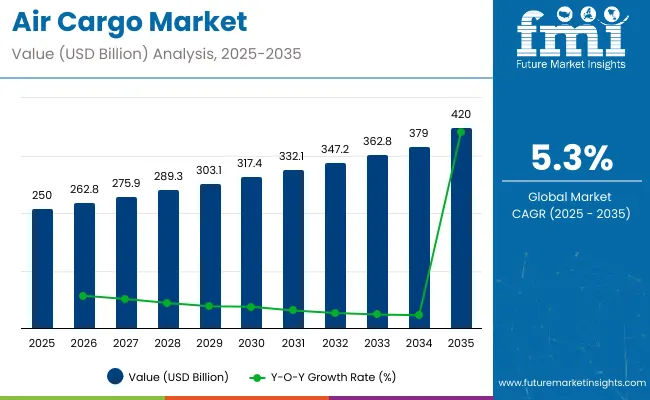
| Metric | Value |
|---|---|
| Industry Size (2025E) | USD 250 billion |
| Industry Value (2035F) | USD 420 billion |
| CAGR (2025 to 2035) | 5.3% |
Saturation point analysis shows that growth will gradually moderate as key markets approach full utilization of existing air freight capacity and infrastructure. Mature regions, including North America and Europe, are nearing operational limits at major hubs, where incremental demand will increasingly be addressed through efficiency improvements rather than network expansion.
Emerging regions, particularly Asia Pacific and parts of the Middle East, continue to present growth opportunities with new cargo hubs, fleet additions, and expanding logistics networks. Short-term variability in demand is influenced by seasonal trade cycles, fuel price changes, and global economic conditions, yet the long-term trajectory remains positive. Saturation points are further shaped by technological adoption, including automated cargo handling, larger freighter aircraft, and digital tracking systems, which enhance capacity without proportional infrastructure investment. Monitoring saturation trends enables stakeholders to optimize operations, integrate technology, and plan strategic routes, ensuring continued value creation. Even as mature markets stabilize, regional expansion and process improvements allow the market to sustain steady growth and strengthen its overall resilience over the decade.
The air cargo market is influenced by several core sectors. Airline operators and freighters represent around 43%, managing the majority of cargo transport and fleet operations. Logistics and freight forwarding companies contribute approximately 27%, coordinating shipment routing, customs clearance, and supply chain management. Airport infrastructure and ground handling services account for nearly 15%, providing warehousing, loading, and cargo handling facilities. E-commerce and retail shippers make up close to 10%, driving demand for express air shipments. Aviation technology and tracking solutions comprise the remaining 5%, offering cargo monitoring, security, and fleet optimization systems.
The air cargo sector has seen strong growth due to e-commerce expansion and global trade recovery. Global air freight volumes reached over 65 million tons in 2024, representing a 6% increase year-on-year. Express shipments for high-value goods now constitute nearly 30% of total cargo revenue, while perishables and pharmaceuticals are rising segments. Digital tracking and AI-based route optimization have reduced transit times by 10–12%, improving reliability and efficiency. Airlines are investing in larger freighters and converted passenger aircraft to meet surging demand. Sustainability initiatives, including more fuel-efficient aircraft and carbon-offset programs, are increasingly influencing fleet planning and operational strategies.
The air cargo market is valued at USD 250 billion in 2025 and is projected to reach USD 420 billion by 2035. Freight tonnage is expected to rise from 60 million tons in 2025 to 98 million tons in 2035, driven by the growth of e-commerce, express delivery services, and global trade expansion. Asia Pacific leads the market with around 40% of total freight volume, followed by North America at 25% and Europe at 20%. Key cargo categories include pharmaceuticals, perishables, and electronics, collectively contributing nearly 50% of revenue.
E-commerce growth and cross-border trade are significantly boosting air cargo demand. Express parcel shipments are increasing at an estimated 8 to 9% annually, with electronics, pharmaceuticals, and consumer goods accounting for nearly 50% of total revenue. Airlines are optimizing capacity by utilizing belly cargo in passenger aircraft and dedicated freighters. Digital tracking, automated documentation, and real-time monitoring enhance reliability and reduce delays. Delivery expectations are evolving, with same-day and next-day options becoming standard in developed markets. In my opinion, air cargo has transformed into a critical enabler of global trade, ensuring rapid delivery of high-value, perishable, and time-sensitive shipments.
Cold chain logistics is emerging as a major growth driver, with the segment expected to expand from USD 35 billion in 2025 to USD 65 billion by 2035. Pharmaceuticals, vaccines, perishable foods, and high-value biotech products require temperature-controlled containers, warehouses, and real-time monitoring. Airlines are expanding dedicated freighter routes for cold chain products, particularly between Asia, Europe, and North America. E-grocery delivery and life sciences sectors are creating additional demand for specialized logistics. From my perspective, carriers investing in cold chain infrastructure and real-time monitoring will capture high-value shipments efficiently and secure long-term contracts.
Digitalization and automation are transforming the air cargo sector. AI powered route optimization and predictive analytics enhance fleet utilization and delivery efficiency. Automated cargo handling, warehouse robotics, and real-time monitoring reduce errors and increase throughput. Integration of digital platforms across shippers, forwarders, and airlines improves transparency and operational efficiency. Cloud-based systems enable continuous tracking and optimization of freight operations. In my view, adoption of AI-driven logistics, IoT enabled monitoring, and automated warehousing will allow carriers to improve efficiency, reliability, and customer satisfaction while meeting rising demand from e-commerce and time-sensitive shipments.
High operational costs and limited capacity remain significant challenges for air cargo operators. Fuel accounts for 30 to 35% of total operating expenses, while maintenance, airport handling, and labor add another 20 to 25%. Limited freighter capacity and airport slot restrictions create bottlenecks during peak seasons. Volatility in fuel prices and global economic fluctuations affect profitability. In my opinion, airlines must invest in fleet modernization, digital infrastructure, and efficient capacity planning to sustain growth. Without addressing high operational costs and capacity constraints, market expansion could slow despite increasing demand for international freight, express logistics, and specialized cargo services.
The market in 2025 is driven by global trade growth, e-commerce expansion, and the rising demand for timely delivery. Air freight dominates with 70% share, while air mail accounts for 30%. Express services capture 55% of the service segment, with general cargo at 45%. International destinations hold 60% of shipments, and domestic destinations represent 40%. Retail, e-commerce, and pharmaceuticals are the leading end users, accounting for 28% and 22% share respectively. Key operators include FedEx, DHL, UPS, and Emirates SkyCargo. Market growth is propelled by fast logistics, cold-chain transport, and sector-specific handling requirements, where digital tracking, fleet optimization, and strategic hubs ensure operational efficiency and timely deliveries worldwide.
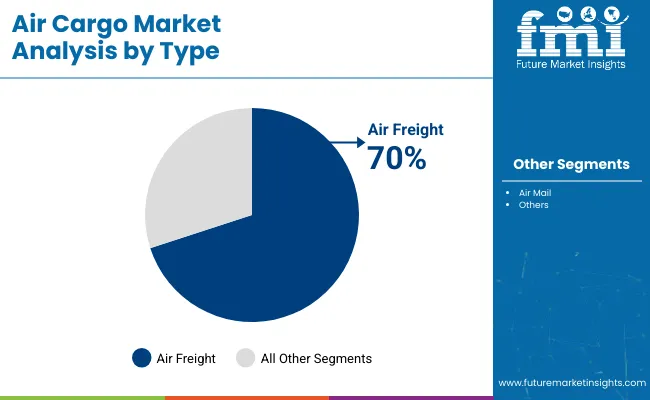
Air freight dominates the type segment with 70% share, handling high-value, time-sensitive goods such as electronics, pharmaceuticals, and automotive components. Air mail contributes 30%, focused on letters, documents, and small parcels requiring scheduled delivery. Leading operators include FedEx, DHL, UPS, and Emirates SkyCargo, offering integrated solutions for express and general cargo. Air freight adoption is driven by globalization, rapid e-commerce growth, and cross-border logistics demand. Air mail retains significance in developing regions where traditional postal systems remain prevalent. Companies optimize fleet allocation, route planning, and cargo consolidation to meet both segments efficiently. Type segmentation ensures flexibility in handling weight, volume, and delivery urgency.
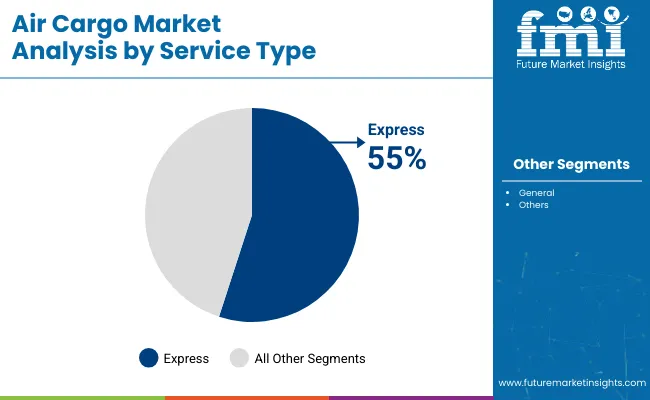
Express services lead with 55% share, catering to urgent shipments, high-value cargo, and cold-chain products. General cargo accounts for 45%, serving standard commercial and industrial shipments. Operators like DHL, FedEx, and UPS focus on express logistics through dedicated fleets, real-time tracking, and priority handling. General services rely on standard cargo planes and shared space for cost efficiency. Express demand is rising due to e-commerce, pharmaceuticals, and electronics requiring quick delivery, while general cargo supports conventional trade and bulk shipments. Market growth depends on integrating technology, predictive scheduling, and optimizing operational cost across both service types.
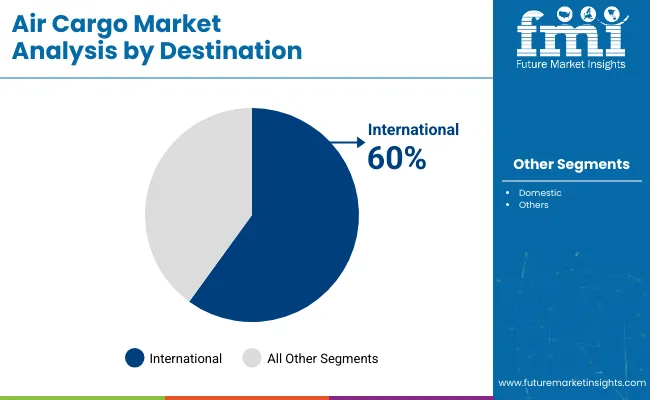
International destinations account for 60% of air cargo volume, supporting cross-border trade, multinational supply chains, and global e-commerce. Domestic shipments represent 40%, catering to regional logistics and last-mile connectivity. Operators including FedEx, UPS, and Emirates SkyCargo leverage hub-and-spoke networks, customs clearance efficiency, and regional partnerships to manage international cargo. Domestic shipments are supported by national carriers and regional airlines ensuring timely delivery. International demand is fueled by high-value goods, perishable items, and industrial components, whereas domestic routes focus on quick intra-country distribution. Network optimization, fleet utilization, and adherence to regulatory frameworks determine efficiency in both international and domestic segments.
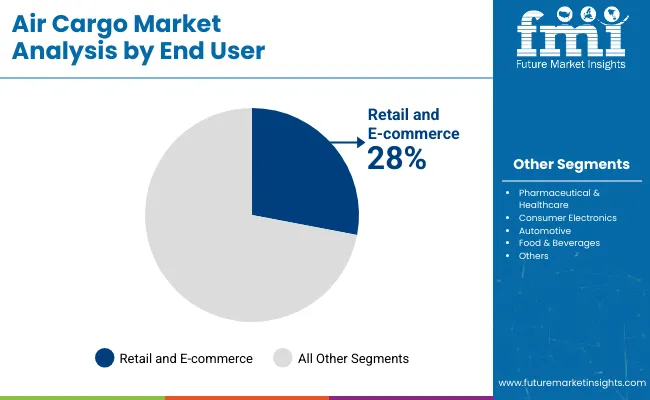
Retail and e-commerce dominate with 28% share, driven by fast delivery expectations and global marketplace integration. Pharmaceuticals and healthcare account for 22%, requiring temperature-controlled transport and regulatory compliance. Consumer electronics hold 18%, automotive 12%, and food & beverages 12%, reflecting perishable and high-value product logistics. Operators like DHL, FedEx, UPS, and Kuehne + Nagel provide end-to-end solutions including express handling, cold-chain logistics, and dedicated cargo facilities. End-user segmentation highlights the role of sector-specific solutions in ensuring timely, safe, and efficient delivery. Market adoption depends on fleet capacity, operational agility, and integration of AI-driven tracking and predictive analytics for optimized performance.
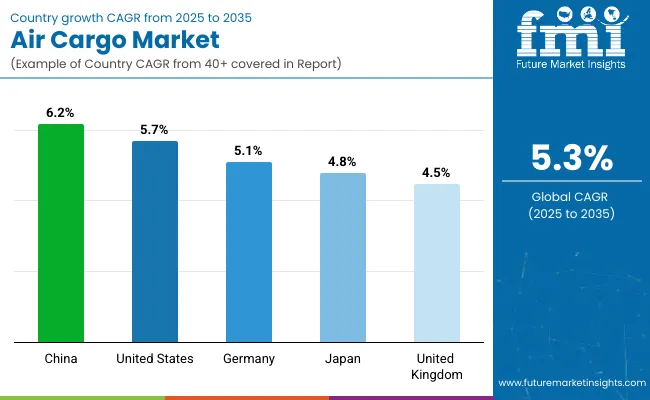
China leads the market with a CAGR of 6.2% from 2025 to 2035, +17% above the global average of 5.3%, driven by BRICS-supported expansion in e-commerce, manufacturing exports, and modern logistics infrastructure. The United States follows at 5.7%, +8% above the global rate, reflecting OECD-backed investments in cargo hubs, fleet modernization, and efficiency-enhancing technologies. Germany records 5.1%, −4% below the global benchmark, with growth shaped by steady demand in established European trade networks and incremental upgrades in air cargo handling. Japan posts 4.8%, −9% under the global rate, influenced by a mature cargo sector and gradual integration of advanced fleet technologies. The United Kingdom stands at 4.5%, −15% below the global CAGR, constrained by limited expansion capacity and moderate adoption of digital logistics solutions. In summary, BRICS nations, particularly China, are driving volume growth, while OECD economies focus on efficiency, technological improvements, and optimized network operations to maintain steady market performance.
The air cargo market in China is expected to grow at a CAGR of 6.2%, fueled by e-commerce, manufacturing exports, and logistics expansion. Major airports including Shanghai Pudong, Shenzhen, and Guangzhou Baiyun handle high volumes of electronics, automotive parts, and pharmaceuticals. Airlines such as China Southern and Air China deploy automated cargo management systems to improve efficiency. Widebody freighters enhance intercontinental shipments, while cold chain systems support perishable and medical goods. Emerging smart airport technologies streamline cargo flow and reduce turnaround times. By 2035, the market is anticipated to continue expanding with emphasis on high-value freight and integrated logistics solutions.
The United States air cargo market is projected to grow at a CAGR of 5.7%, supported by major hubs like Memphis, Louisville, and Chicago. Freight carriers including FedEx Express, UPS Airlines, and Atlas Air utilize AI-based systems for cargo planning and optimization. Growth is fueled by e-commerce, cross-border trade, and increasing demand for perishable goods delivery. Investments in advanced cargo terminals and predictive logistics enhance efficiency, particularly for high-value electronics and industrial components. Widebody aircraft usage continues to expand for both domestic and international shipments.
The air cargo industry in Germany is expected to expand at a CAGR of 5.1%, anchored by Frankfurt and Munich as key European freight hubs. Lufthansa Cargo and DB Schenker handle industrial machinery, automotive parts, and pharmaceuticals. Automation in warehouses and tracking technologies improve efficiency and reduce handling delays. The automotive sector and chemical exports significantly influence demand, with just-in-time supply chains requiring fast and reliable air transport. Investments in energy-efficient freighters and hybrid aircraft support operational sustainability and reduce fuel costs. By 2035, Germany is projected to maintain a strong position in European air freight.
The air cargo industry in Japan is projected to grow at a CAGR of 4.8%, centered around Tokyo Narita, Haneda, and Kansai airports. ANA Cargo and Nippon Cargo Airlines lead in electronics, automotive, and precision machinery transport. Cold chain logistics support seafood and pharmaceutical shipments, while AI-assisted scheduling improves aircraft utilization. Exports to North America and Europe remain strong, and airport automation reduces cargo handling time. The market benefits from Japan’s export-oriented manufacturing sector and advanced logistics infrastructure, focusing on high-value and sensitive goods.
The United Kingdom air cargo market is expected to grow at a CAGR of 4.5%, with London Heathrow and East Midlands airports acting as key hubs. DHL, Virgin Atlantic Cargo, and IAG Cargo manage high-value electronics, pharmaceuticals, and fashion goods. Automation in warehouses, including robotic sorting and cold storage, improves handling efficiency. E-commerce demand and cross-border trade with Europe drive growth, while predictive logistics tools optimize delivery schedules. Investments in infrastructure support faster cargo processing and timely shipments of time-sensitive goods.

Air cargo companies compete by offering faster delivery, broad network coverage, and specialized cargo handling. China Airlines Cargo and Cargolux Airlines International focus on connecting Asia and Europe efficiently, maintaining frequent flights and temperature-controlled services for perishable goods. Turkish Cargo leverages Istanbul as a central hub to streamline transcontinental shipments. FedEx Express and UPS Airlines use advanced logistics technology, predictive tracking, and dedicated freight solutions to secure reliability and speed for time-sensitive deliveries.
Emirates SkyCargo and Qatar Airways Cargo attract high-value shipments by providing premium handling, wide cargo space, and flexible routing. DHL Aviation and Singapore Airlines Cargo focus on integrated services, combining air freight with ground transportation for end-to-end solutions. Korean Air Cargo and Cathay Pacific Cargo offer specialized freight options such as pharmaceuticals, e-commerce goods, and oversized cargo. The competition intensifies through fleet expansion, partnerships, and optimized scheduling to reduce transit times while maximizing capacity.
Marketing relies on product brochures and digital catalogs highlighting cargo types, handling options, and global destinations. Brochures emphasize efficiency, safety, and reliability, helping clients select tailored solutions for their business. Some digital brochures include route maps, transit timelines, and service comparisons to improve customer experience. Each presentation positions the carrier as a dependable partner for critical shipments while keeping information concise and practical. Clarity, speed, and service quality remain the focus rather than promotional language.
| Report Attributes | Details |
|---|---|
| Market Size (2025) | USD 250 billion |
| Projected Market Size (2035) | USD 420 billion |
| CAGR (2025 to 2035) | 5.3% |
| Base Year for Estimation | 2024 |
| Historical Period | 2020 to 2024 |
| Projection Period | 2025 to 2035 |
| Quantitative Units | USD billion for value |
| Type Segments | Air Freight, Air Mail |
| Service Segments | Express, General |
| Destination Segments | Domestic, International |
| End-User Segments | Retail & E-commerce, Food & Beverages, Pharmaceutical & Healthcare, Consumer Electronics, Automotive, Others |
| Regions Covered | North America, Latin America, Western Europe, Eastern Europe, Asia Pacific, Middle East & Africa |
| Countries Covered | United States, Canada, Brazil, Mexico, Germany, United Kingdom, France, Italy, China, Japan, India, UAE, Saudi Arabia, South Africa, Australia |
| Leading Players | FedEx Express, UPS Airlines, DHL Aviation, Emirates SkyCargo, Qatar Airways Cargo, China Airlines Cargo, Cargolux Airlines International, Turkish Cargo, Korean Air Cargo, Cathay Pacific Cargo, Singapore Airlines Cargo |
| Additional Attributes | Dollar sales by cargo type and service, demand dynamics across express and general freight, regional trends in domestic and international shipments, innovation in temperature-controlled logistics, digital tracking, AI-based route optimization, and environmental impact of emissions reduction in air logistics |
The market size is valued at USD 250 billion in 2025.
It is projected to reach USD 420 billion by 2035.
The market is expected to grow at a CAGR of 5.3% during 2025-2035.
Air Freight holds the largest share with 70% in 2025.
FedEx Express, UPS Airlines, and DHL Aviation are among the leading players.






Full Research Suite comprises of:
Market outlook & trends analysis
Interviews & case studies
Strategic recommendations
Vendor profiles & capabilities analysis
5-year forecasts
8 regions and 60+ country-level data splits
Market segment data splits
12 months of continuous data updates
DELIVERED AS:
PDF EXCEL ONLINE
Aircraft Cargo Containers Market Size and Share Forecast Outlook 2025 to 2035
Aircraft Cargo Handling Equipment Market
Aircraft Cargo Winches Market
Airport Ground Transportation Market Forecast and Outlook 2025 to 2035
Airless Sprayer Accessories Market Size and Share Forecast Outlook 2025 to 2035
Air Purge Valve Market Size and Share Forecast Outlook 2025 to 2035
Air Flow Sensors Market Size and Share Forecast Outlook 2025 to 2035
Air Separation Plant Market Size and Share Forecast Outlook 2025 to 2035
Air Cooled Turbo Generators Market Size and Share Forecast Outlook 2025 to 2035
Aircraft Cooling Turbines Market Size and Share Forecast Outlook 2025 to 2035
Air Conditioning Compressor Market Size and Share Forecast Outlook 2025 to 2035
Air Measuring Equipment Market Size and Share Forecast Outlook 2025 to 2035
Aircraft Smoke Detection and Fire Extinguishing System Market Size and Share Forecast Outlook 2025 to 2035
Aircraft Hose Fittings Market Size and Share Forecast Outlook 2025 to 2035
Aircraft Cabin Interior Market Size and Share Forecast Outlook 2025 to 2035
Aircraft Galley Systems Market Size and Share Forecast Outlook 2025 to 2035
Aircraft Interior Lighting Market Size and Share Forecast Outlook 2025 to 2035
Aircraft Battery Market Size and Share Forecast Outlook 2025 to 2035
Aircraft Floor Panels Market Size and Share Forecast Outlook 2025 to 2035
Aircraft Fuel Systems Market Size and Share Forecast Outlook 2025 to 2035

Thank you!
You will receive an email from our Business Development Manager. Please be sure to check your SPAM/JUNK folder too.
Chat With
MaRIA